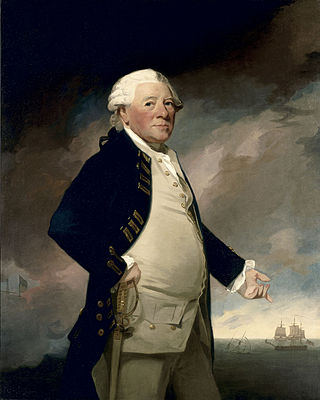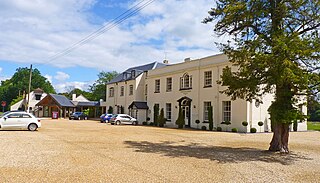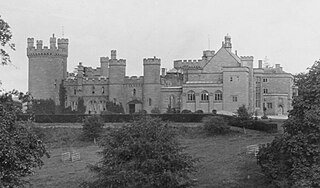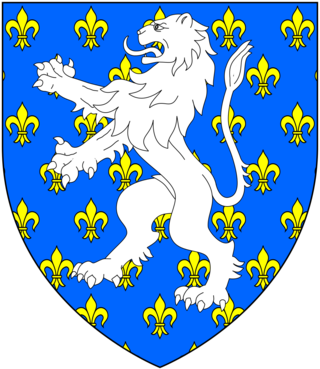Sources
- Kidd, Charles, ed. (1903). Debrett's peerage, baronetage, knightage, and companionage. London: Dean and son. p. 414.
- Leigh Rayment's list of baronets
- "No. 13318". The London Gazette . 18 June 1791. p. 363.
Related Research Articles

Marquess of Anglesey is a title in the Peerage of the United Kingdom. It was created in 1815 for Henry Paget, 2nd Earl of Uxbridge, a hero of the Battle of Waterloo, second in command to the Duke of Wellington. The Marquess holds the subsidiary titles of Earl of Uxbridge, in the County of Middlesex, in the Peerage of Great Britain (1784), Baron Paget, de Beaudesert, in the Peerage of England (1553), and is also an Irish Baronet, of Plas Newydd in the County of Anglesey and of Mount Bagenall in the County of Louth.

The Eliott Baronetcy, of Stobs in the County of Roxburgh, is a title in the Baronetage of Nova Scotia. It was created on 3 December 1666 for Gilbert Eliott. The second baronet was a member of the pre-union Parliament of Scotland. The third Baronet sat as Member of Parliament for Roxburghshire. The Eliott Baronets share a common early Elliot ancestry with the nearby Earls of Minto (Elliot). It is thought that the surname spelling differences were contrived to differentiate the branches.
There have been five baronetcies created for people with the surname Forbes, four in the Baronetage of Nova Scotia and one in the Baronetage of the United Kingdom. The first holder of the Burn baronetcy of Jessfield, created in the Baronetage of the United Kingdom in 1923, assumed the surname of Forbes-Leith of Fyvie in 1925.

There have been seven baronetcies created for persons with the surname Parker, three in the Baronetage of England, two in the Baronetage of Great Britain and two in the Baronetage of the United Kingdom. Two of the creations are extant as of 2008. Though none of the different families of baronets were related, several supplied a number of flag officers to the Royal Navy.

Sir George Ivison Tapps, 1st Baronet was a British landowner and developer involved in the founding of Bournemouth.

Hinton Admiral is the estate and ancestral home of the Tapps-Gervis-Meyrick family and located in the settlement of Hinton, near Bransgore in Hampshire, England. It is a Grade I Listed building.

Sir George William Tapps-Gervis, 2nd Baronet was a British politician and land developer.
Sir George Eliott Meyrick Tapps-Gervis-Meyrick, 3rd Baronet was a land owner and developer, and served as High Sheriff of Anglesey in 1878.
The Meyrick Baronetcy, of Bush House in the parish of St Mary in the County of Pembroke and of Apley Castle in the parish of Wellington in the County of Salop, is a title in the Baronetage of the United Kingdom. It was created on 5 May 1880 for Thomas Meyrick, Conservative Member of Parliament for Pembroke from 1868 to 1874. Born Thomas Charlton, he had assumed by Royal licence the surname of Meyrick in lieu of his patronymic in 1858. As of 2007 the presumed fifth Baronet has not successfully proved his succession and is therefore not on the Official Roll of the Baronetage.
The Colyer-Fergusson baronetcy, of Spitalhaugh in the County of Peebles and of George Street in the parish of St George Hanover Square in the County of Middlesex, was a title in the Baronetage of the United Kingdom. It was created on 23 January 1866 for the Scottish surgeon William Fergusson. The second Baronet served as Vice-Lieutenant of Peeblesshire. The third Baronet assumed the additional surname of Colyer in 1890 and served as high sheriff of Kent in 1906. The title became extinct on the death of the fourth Baronet in 2004.
There have been three baronetcies created for persons with the surname Clayton, two in the Baronetage of Great Britain and one in the Baronetage of the United Kingdom. One creation is extant as of 2021.

The Smith, later Bromley, later Pauncefote-Bromley, later Bromley-Wilson, later Bromley Baronetcy, of East Stoke in the County of Nottingham, is a title in the Baronetage of Great Britain. It was created on 31 October 1757 for the banker George Smith, High Sheriff of Nottinghamshire from 1757 to 1759. He was the eldest son of Abel Smith I (1686–1756) of Nottingham, the 2nd son of Thomas Smith I (1631–1699), the founder of Smith's Bank in Nottingham. His younger brothers included: Abel Smith II (1717–1788) and John Smith, ancestor of Julian Pauncefote, 1st Baron Pauncefote.
The Fuller-Eliott-Drake Baronetcy, of Nutwell Court, Buckland Abbey, or Monachorum, Sherford, and Yarcombe in the County of Devon, was a title in the Baronetage of the United Kingdom. It was created on 22 August 1821 for the soldier Thomas Fuller-Eliott-Drake, with remainder in default of male issue of his own to his next two younger brothers, William Stephen Fuller and Rose Henry Fuller, and their male issue. Born Thomas Fuller, he was a grandson of George Augustus Eliott, 1st Baron Heathfield, and grand-nephew of the last Drake Baronet of Buckland, and adopted the additional surnames of Eliott and Drake upon his inheritance of Buckland Abbey and Nutwell Court from the second Lord Heathfield in 1813. He was succeeded according to the special remainder by his nephew, the second Baronet, a son of the younger of his two brothers, who had also adopted the additional surnames. The title became extinct upon his death without a male heir in 1916. The second Baronet's only child married the third Baron Seaton, who also adopted the Eliott and Drake surnames.

The Broke, later Broke–Middleton Baronetcy, of Broke Hall in the County of Suffolk, was a title in the Baronetage of the United Kingdom. It was created on 2 November 1813 for Philip Broke, a Rear-Admiral of the Royal Navy. He was the grandson of Robert Broke, nephew of Sir Robert Broke, 1st Baronet, of Nacton, who were both descended from Sir Richard Broke, Chief Baron of the Exchequer during the reign of Henry VIII. The second Baronet was Sheriff of Suffolk in 1844 and his younger brother the third Baronet was Sheriff of Suffolk in 1864. The third Baronet assumed the additional surname of Middleton in 1860 after inheriting the estate of his cousin Sir William Fowle Fowle-Middleton. The title became extinct on his death in 1887.

Bodorgan Hall is a country house and estate located in the hamlet of Bodorgan, Anglesey, Wales, situated near the Irish Sea in the southwestern part of the island. The hall is the seat of the Meyricks, and is the largest estate on Anglesey. The hall is the home of Sir George Meyrick and his wife, Lady Candida Tapps Gervis Meyrick.

East Close House in Hinton, Hampshire, near Christchurch, Dorset, is a building of historical significance and a grade II listed building on the English Heritage Register. A mansion house stood on the site by 1742, which may be that crudely illustrated on Taylor's Hampshire map of 1759. Many notable people resided here before its conversion to a hotel in the 1930s. It was announced in August 2018 that the hotel would close later in the year.

St Cadwaladr's Church is a Grade I listed church in Llangadwaladr, Anglesey. The location of the current church was established in the 7th century by the Kings of Gwynedd, after whom the church is named, King Cadwaladr. The Church standing today was built in the 'T' shape perpendicular style. The nave is dated to the 12th to early 13th century and the chancel to the 14th. Later the chapels were built, the north in 1640 and the southern Bodowen Chapel in 1661. Then, during 1856 the church underwent restoration, at which time to south porch was added.

The Meyrick family of Bodorgan, Anglesey, Wales is descended from Cadafael, lord of Cedewain, Powys.

The Pole, later de-la-Pole, later Reeve-de-la-Pole Baronetcy, of Shute House in the County of Devon, was created in the Baronetage of England on 12 September 1628 for John Pole, Member of Parliament for Devon. It was created during the lifetime of his father, the historian of Devon, Sir William Pole (d.1635), Knight, MP, of Colcombe Castle and Shute in Devon. The second Baronet was Member of Parliament for Honiton. The third Baronet represented Lyme Regis, Bossiney, Devon, East Looe and Newport in the House of Commons. The fourth Baronet was Member of Parliament for Newport, Camelford, Devon, Bossiney and Honiton. The sixth Baronet represented West Looe in Parliament. In 1790 he assumed the surname of de-la-Pole, which his successor discontinued. The eighth Baronet assumed in 1838 the surname of Reeve-de-la-Pole but later discontinued it.
References
- ↑ "MEYRICK family, Bodorgan, Anglesey.". Dictionary of Welsh Biography . National Library of Wales.
- ↑ "GEORGE MEYRICK ANNOUNCED AS NEW CHANCELLOR OF BANGOR UNIVERSITY". bangor.ac.uk. 17 December 2017.